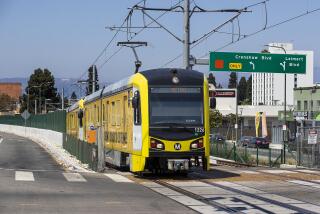Rail System Rated Better for Reducing Commutes
- Share via
SANTA ANA — Building additional freeway lanes would significantly reduce traffic congestion, but a light-rail system would save commuters more time.
Those are among the findings of a report on improving the commute along the 28-mile-long, 6-mile-wide swath from Fullerton to Irvine, the most traveled corridor in the county. The Orange County Transportation Authority Board of Directors accepted the study Monday over protests that it is flawed.
Bill Ward, chairman of Drivers for Highway Safety, told the board that much of the data behind the report’s findings are unverifiable. “I’d like to see whose hat this particular rabbit came out of,” he said. “It’s like a Ouija board; there’s no substantiation.”
But Nancy Michali, OCTA’s manager of transit planning, dismissed most of the group’s criticisms, saying, “They did point out a few typos, for which we thank them.”
The $3-million effort--called the Major Investment Study--is seen as the foundation for a plan to spend about $340 million in Measure M sales tax funds earmarked for developing rail systems.
In order to do that, however, the agency is required by law to study all its options, although Ward and other critics have charged that the study is stacked in favor of rail.
OCTA officials say they are being objective. The agency will spend three months gathering public comment on the study and make a final decision in June.
Options are outlined in the study of the heavily traveled corridor, which contains 34% of the county’s residents and 57% of its jobs, and generates more than 60%--or about 5.1 million--of its total number of trips per day.
The transportation possibilities are:
* Improve roads, bus and rail systems without adding anything new.
* Add more buses and bus routes.
* Add carpool lanes to freeways and extend the Orange Freeway in the form of a toll road.
* Build an elevated light-rail system on new track between Fullerton and Irvine.
* Build a partly elevated rail system using MetroLink lines.
Last summer, Ward and his group persuaded OCTA to add another option, one which they have long favored--increasing the number of regular lanes, as opposed to carpool lanes, on the Orange Freeway.
That alternative, said Jack Mallinckrodt, a member of the group, is “far and away, the most cost-effective.”
Indeed, according to the study, adding more regular (or mixed-flow) lanes to the freeway would cost less to build than either rail system (about $1.42 billion), have the lowest annual operating cost (about $1.2 million) and provide the greatest reduction (about 5%) of freeway congestion through the corridor.
On the other hand, the study concluded, more freeway lanes would cut commute times by considerably less than most of the other options and would not be eligible for any of the $340 million in Measure M transit funds.
Among the study’s other findings:
* Commute times would be shortened the most by adding more buses. The second-highest travel time savings would be achieved by building a rail system.
* Enhanced bus service would be more cost-effective than rail.
* Ridership projections indicate some support for a rail system in Orange County.
More to Read
Sign up for Essential California
The most important California stories and recommendations in your inbox every morning.
You may occasionally receive promotional content from the Los Angeles Times.










